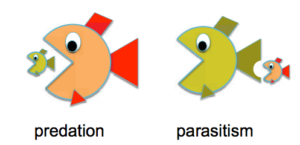What is the difference between predation and parasitism?
Difference interact with each other in the ecosystem in different ways. Predation and parasitism are examples of interspecific interaction in the ecosystem.
The core difference between predation and parasitism is that predation is where predators catch and kill the prey for food while parasitism is where the parasite benefits from the host and cause a negative impact.

What Is Predation?
Predation is an interspecific interaction between predators and prey. The predator catches and kills the prey for food as well as energy.
The type of interaction tends to show a positive impact on the predators and a negative impact on the prey. The main role of predation is to keep the population under control.
Examples of predation are where lion feed of gazelles, bears eating fish and foxes feeding on rabbits. Predators can either be animals or plants.
What Is Parasitism?
Parasitism is another interspecific interaction between the parasite and host. The parasite tends to obtain food and shelter from the host.
The type of interaction tends to benefit parasites more than the host. Continuous invasion of the parasite in the body of the host decreases their health in the long run.
Parasites can either be endoparasites or ectoparasites. The endoparasites live in the body of the host while ectoparasites live outside the body of the host.
Examples of parasites are tapeworm, roundworm, hookworm, lice, mosquitoes, ticks, flukes, and bacteria among many others.
Comparison Chart: Predation Vs Parasitism
| Basic Terms | Predation | Parasitism |
| Definition | It is the act in which one animal prey for another animal for food and energy | It is the act where one animal live with or on another as a parasite for shelter and food |
| Association | Between prey and predator | Between parasite and host |
| Specificity | Have many types of prey | Have a specific host |
| Metabolic Dependency | Tend to lack metabolic dependency | Parasite depend on the host for metabolic dependency |
| Size | Predator is large and stronger than prey | Parasites are smaller than the host organism |
| Progression | Predators are active and use a lot of physical effort | Tend to be passive |
| Killing the Other | Instant kill the prey | Do not kill the host immediately |
| Completion of the Life Cycle | Both prey and predator have an independent life cycle | Parasites require a host to complete life cycle |
| Examples | A lion eats Gazelles, Fox eat Rabbit, Bear eat Fish | Ticks, Lice, Bacteria, Flukes, tapeworm, roundworm |
Core Difference between Predation and Parasitism
- Predation is the act of preying on another animal for food and energy while parasitism is the act of living as a parasite with or on another animal for food and shelter.
- Parasitism result in an association between the host and parasite while predation result in an association between prey and predator
- Predation has several preys while parasitism has a specific host
- Parasitism depend on the host for metabolic activity while predation does not depend on prey for metabolic activity
- Predators are stronger and larger than preys while parasites are smaller than host
- Predators use physical effort and active progression to catch the prey while parasitism has a passive progression
- Predators kill the prey immediately while parasites do not kill the host immediately
- Predator and prey have an independent life cycle while parasite depends on the host to have a complete life cycle.
- Examples of parasitism are lice, bacteria, roundworms, tapeworms, and ticks while predation examples are bears eat fish, fox eats rabbits and lion eat zebra.
Read More: Difference between Symbiotic and Mutualistic Organism
Similarities between Predation and Parasitism
- Both exhibit interspecific interaction
- Both evolve in the same ecosystem
- Both are harmful and beneficial to the species
Comparison Video
Summary
Predation and parasitism are the interspecific relationship between two different species in an ecosystem. They are part of abiotic factors of the ecosystem and they help in the control of the population.
Read More: Difference between Symbiotic, Commensalism, and Parasitism